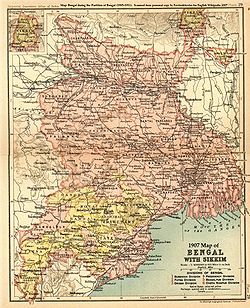
Orissa famine of 1866
Encyclopedia

Causes
Like all Indian famines of the 19th-century, the Orissa famine was preceded by a drought: the population of the region depended on the rice crop of the winter season for their sustenance; however, the monsoon of 1865 was scanty and stopped prematurely. In addition, the Bengal Board of Revenue made incorrect estimates of the number of people who would need help and was misled by fictitious price lists. Consequently, as the food reserves began to dwindle, the gravity of the situation was not grasped until the end of May 1866, and by then the monsoons had set in.Course and relief
Efforts to ship the food to the isolated province were hampered because of bad weather, and when some shipments did reach the coast of Orissa, they could not be moved inland. The British Indian government imported some 10,000 tons of rice, but they didn't reach the affected population before September. Although many people died of starvation, more were killed by cholera before the monsoons and by malaria afterwards. In Orissa alone, at least 1 million people, a third of the population, died in 1866, and overall in the region approximately 4 to 5 million died in the two-year period.The heavy rains of 1866 also caused floods which destroyed the rice-crop in low-lying regions. Consequently, in the following year, another shortfall was expected, and the Government of British India imported approximately 40,000 tons of rice at four times the usual price. However, this time they over-estimated the need and only half the rice was used by the time the summer monsoon of 1867 followed by a plentiful harvest, ended the famine in 1868. In the two years of the famine, the Government of British India spend approximately Rs. 95 lakh
Lakh
A lakh is a unit in the Indian numbering system equal to one hundred thousand . It is widely used both in official and other contexts in Pakistan, Bangladesh, India, Maldives, Nepal, Sri Lanka, Myanmar and is often used in Indian English.-Usage:...
s on famine relief for 35 million units (i.e. one person per day); a large proportion of the cost, however, was the high price of the imported grain.
See also
- Timeline of major famines in India during British rule (1765 to 1947)Timeline of major famines in India during British rule (1765 to 1947)This is a timeline of major famines on the Indian subcontinent during the years of British rule in India from 1765 to 1947. The famines included here occurred both in the princely states and British India This is a timeline of major famines on the Indian subcontinent during the years of British...
- Famines, Epidemics, and Public Health in the British RajFamines, Epidemics, and Public Health in the British RajAmong the common features of famines, epidemics, and public health in the British Raj during the 19th century were:* There was no aggregate food shortage in India, although there were localized crop failures in the affected areas...
- Company rule in IndiaCompany rule in IndiaCompany rule in India refers to the rule or dominion of the British East India Company on the Indian subcontinent...
- Famine in IndiaFamine in IndiaFamine has been a recurrent feature of life in the Indian sub-continental countries of India, Pakistan and Bangladesh, and reached its numerically deadliest peak in the late eighteenth and nineteenth centuries. Historical and legendary evidence names some 90 famines in 2,500 years of history. There...
- Drought in IndiaDrought in IndiaDrought in India has resulted in tens of millions of deaths over the course of the 18th, 19th, and 20th centuries. Indian agriculture is heavily dependent on the climate of India: a favorable southwest summer monsoon is critical in securing water for irrigating Indian crops...

